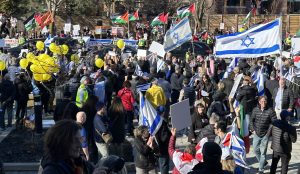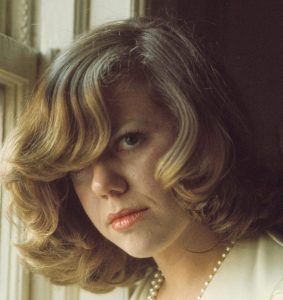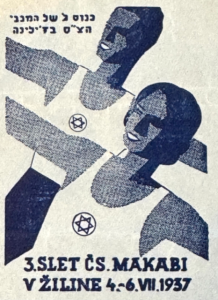The majority of Jewish victims of the Shoah were Yiddish speakers. One-third of the Jews of the world were killed in the Shoah, but they comprised a much higher percentage of the world’s Yiddish speakers. While the Jewish people have, thank God, managed to recover and thrive since then, many fear that the Shoah was essentially a deathblow for the Yiddish language.
Optimistic Yiddishists find signs of life for the Yiddish language. One of the most surprising ones is the resurgence of interest in Yiddish in the academic world. The number of students actually studying the Yiddish language at most universities is low, but the number of professors researching and writing about Yiddish language, literature and culture is growing quickly.
For example, a new collection of academic essays has recently been published: Choosing Yiddish: New Frontiers of Language and Culture, edited by Lara Rabinovitch, Shiri Goren and Hannah S. Pressman. It contains 19 scholarly articles about Yiddish, all written in English, mostly by young academics.
Categories include “Yiddish and the City,” “Yiddish Comes to America,” and “Yiddish Encounters Hebrew.” Although the editors explain in the introduction why the Shoah was not one of the groupings they used, nevertheless, their decision is puzzling, since the relationship between Yiddish and the Shoah shines through in a number of the essays.
My York University colleague, Kalman Weiser, has a fascinating article here about tensions within YIVO (the Yidisher Visnshaftlekher Institut [the Yiddish Scientific Institute, later renamed in English the Institute for Jewish Research]) between 1939 and 1940. The Amopteyl (short for Amerikaner opteyl or American Division) of YIVO took hesitant steps to move control of the organization and its publications to New York, at the time the city with the largest number of Yiddish speakers in the world, from the group’s head office in Vilna. The YIVO office in Vilna was not pleased. It continued to see Europe, not the United States, as the centre of Yiddish culture and it was not willing to cede YIVO leadership to the Americans. Weiser’s essay sheds light on the question of how much Jews in either the U.S. or Lithuania understood in 1939-1940 that the cultural dominance of Eastern European Jewry was over and that their physical end was near. Weiser highlights some of the curious ways that Lithuanian and American Yiddishists regarded each other then. In March 1940, the New York Yiddish newspaper Forverts wrote: “The problem with our America is what is called here making ‘a living,’ and in the present time it diverts much time and causes much concern. It is, however, different in Vilna. There, they don’t make a living. The means don’t exist… Therefore, they have more time and more patience for scholarly work.”
Another Shoah-related essay is by Shiri Goren, of Yale University. She tells the moving story of the Hebrew poet and author, David Vogel (1891-1944), who was born in the Ukraine and moved first to Austria, then to the land of Israel, and eventually to France. There he was rounded up by the Gestapo and sent to Auschwitz, where he was killed in March 1944. Throughout his literary career, Vogel, a native Yiddish speaker, wrote and published only in Hebrew. But just before he was captured by the Nazis, he buried a manuscript that he had written entirely in Yiddish in the backyard of a home in Hauteville, in southeastern France. This very long manuscript of almost 150,000 words was found after the war and published both in the Yiddish original and in a Hebrew translation. Goren discusses what might have led a committed Hebraist like Vogel to return to his Yiddish roots as he felt his world coming to an end.
Aside from Shoah-related essays the book has other interesting pieces, a number of them with Canadian content. Shayn E. Smulyan of Brown University analyzes the use of Yiddish in the works of the Canadian hip-hop artist, SoCalled (born Josh Dolgin in small-town Quebec). Rebecca Margolis of the University of Ottawa describes the growth and initial success of Montreal’s Yiddish-speaking National Secular Schools between 1910 and 1950. In 1955, New York City’s Yiddish paper Tog-morgn zhurnal claimed that “if there has ever been the possibility of Jewish/Yiddish autonomy in English North America, it was in Montreal.” Even today, Margolis writes, “Montreal stands out as home to one of the very few secular Jewish day school systems that continues to teach Yiddish” both at the elementary and high school levels. But the challenges were formidable even in the ’20s and ’30s of the last century. One Montreal Jewish educator wrote: “I recall going around in the hallways or in the yard at recess and telling the students, ‘redt yidish’ [speak Yiddish]. This went on for several years until we concluded that it was pointless.”
The range of topics covered is surprisingly wide, from the treatment in the Yiddish press of the 1876 murder trial of Pesach Rubenstein, the “Hasidic slasher,” to the political poems written in Yiddish by Jewish leftists who were outraged by the conviction in 1920 of two Italian immigrant workers Nicola Sacco and Bartolomeo Vanzetti for murder in South Braintree, Massachusetts, on very flimsy evidence.
I enjoyed this book and recommend it if you’re interested in Yiddish. But aside from the unsystematic treatment of the Shoah, I was surprised by another glaring absence. Only one of the nineteen essays said anything about the tens of thousands or perhaps hundreds of thousands of contemporary haredi Jews who speak Yiddish on a daily basis. With no disrespect for the scholars in this book, I would suggest that the real story of the survival of Yiddish now and possibly in the future is being played out not in academia or in the world of hip-hop, but in these religious enclaves in Israel and North America. While the academic study of haredim can be challenging, scholars who care about the future of Yiddish would be wise to pay close attention to the only sizable community that is really “choosing Yiddish” in our post-Shoah world.






